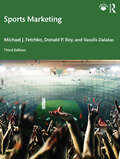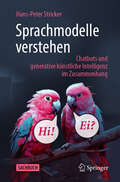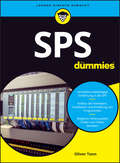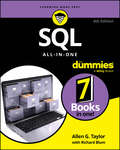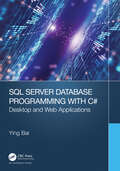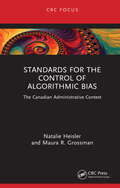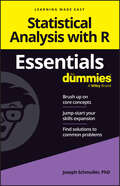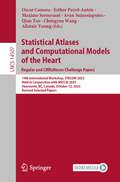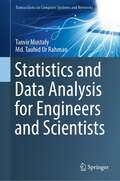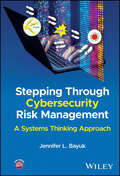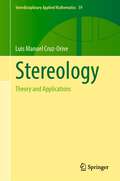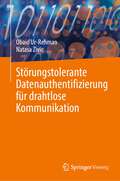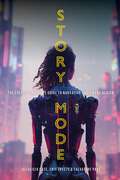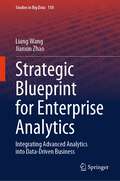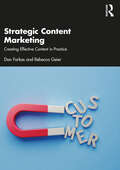- Table View
- List View
Sports Marketing
by Michael J. Fetchko Donald P. Roy Vassilis DalakasHighly practical and engaging, Sports Marketing equips students with the skills, techniques, and tools they need to be successful marketers in any sporting environment. The book blends relevant marketing theory—focusing on industry-specific terminology and practices—with practitioner insights into current issues and future directions in the sports industry. This anticipated third edition has been fully updated to incorporate a broad range of global and diverse perspectives from industry experts and international case studies throughout. Contemporary topics within the sports industry have been expanded upon, including esports, social responsibility, sustainability, digital and social media, and personal branding. Popular "You Make the Call" cases, insider and early career insights, and review questions stimulate lively classroom discussion, while chapter summaries and terms support further support learning. Overall, this exciting text will: • Increase students’ depth of knowledge about sports marketing • Challenge students to apply concepts to real-world situations • Profile best practices of organizations and individuals within the sports industry as they relate to the book’s content • Equip students to position themselves to compete for entry-level positions in sports business • Provide faculty with a concise but thorough text that meets their needs. Sports Marketing remains a core textbook for undergraduate and postgraduate students of sports marketing and management, providing a firm grasp of the ins and outs of working in sports. Additional online resources include PowerPoint slides for each chapter, a test bank of questions, and an instructor’s manual.
Sports Marketing
by Michael J. Fetchko Donald P. Roy Vassilis DalakasHighly practical and engaging, Sports Marketing equips students with the skills, techniques, and tools they need to be successful marketers in any sporting environment. The book blends relevant marketing theory—focusing on industry-specific terminology and practices—with practitioner insights into current issues and future directions in the sports industry. This anticipated third edition has been fully updated to incorporate a broad range of global and diverse perspectives from industry experts and international case studies throughout. Contemporary topics within the sports industry have been expanded upon, including esports, social responsibility, sustainability, digital and social media, and personal branding. Popular "You Make the Call" cases, insider and early career insights, and review questions stimulate lively classroom discussion, while chapter summaries and terms support further support learning. Overall, this exciting text will: • Increase students’ depth of knowledge about sports marketing • Challenge students to apply concepts to real-world situations • Profile best practices of organizations and individuals within the sports industry as they relate to the book’s content • Equip students to position themselves to compete for entry-level positions in sports business • Provide faculty with a concise but thorough text that meets their needs. Sports Marketing remains a core textbook for undergraduate and postgraduate students of sports marketing and management, providing a firm grasp of the ins and outs of working in sports. Additional online resources include PowerPoint slides for each chapter, a test bank of questions, and an instructor’s manual.
Sprachmodelle verstehen: Chatbots und generative künstliche Intelligenz im Zusammenhang
by Hans-Peter StrickerDieses Buch befasst sich mit Fragen rund um Sprachmodelle wie ChatGPT und um das Verstehen: Verstehen Chatbots, was wir ihnen sagen und meinen? Wie können uns Chatbots helfen, etwas besser zu verstehen - einen Text oder ein Konzept? Verstehen Sprachmodelle sich selbst - was sie sagen und warum sie es sagen?Können wir Sprachmodelle verstehen und wie?Das Buch richtet sich an technisch und philosophisch interessierte Laien, aber auch an Didaktiker aller Couleur, von der Lehrkraft bis zu Wissenschaftsjournalist:innen.
SPS für Dummies (Für Dummies)
by Oliver TonnSPS ohne Stress Wenn Sie Maschinen oder Anlagen mithilfe einer SPS auch ohne Vorkenntnisse steuern möchten, dann ist dieses Buch für Sie gemacht. Ob Aufbau der Hardware, Installation und Verdrahtung oder Erstellung von Programmen: Jederzeit leicht verständlich erläutert Ihnen Oliver Tonn Grundlagen und fortgeschrittene Techniken der SPS-Programmierung. Dabei lernen Sie SPS sowohl herstellerunabhängig kennen als auch Besonderheiten der verschiedenen Hersteller. Mit zahlreichen Praxisbeispielen vertiefen Sie Ihr Wissen und wenden es schon bald in komplexeren Szenarien erfolgreich an. Sie erfahren Wie Sie ein SPS-Projekt und -Programm erstellen Wie Sie einen Antrieb steuern Wie Sie mit TwinCAT 3 und TIA visualisieren Wie Sie Fehler vermeiden und beheben
SQL All-in-One For Dummies
by Allen G. Taylor Richard BlumThe most thorough SQL reference, now updated for SQL:2023 SQL All-in-One For Dummies has everything you need to get started with the SQL programming language, and then to level up your skill with advanced applications. This relational database coding language is one of the most used languages in professional software development. And, as it becomes ever more important to take control of data, there’s no end in sight to the need for SQL know-how. You can take your career to the next level with this guide to creating databases, accessing and editing data, protecting data from corruption, and integrating SQL with other languages in a programming environment. Become a SQL guru and turn the page on the next chapter of your coding career. Get 7 mini-books in one, covering basic SQL, database development, and advanced SQL concepts Read clear explanations of SQL code and learn to write complex queries Discover how to apply SQL in real-world situations to gain control over large datasets Enjoy a thorough reference to common tasks and issues in SQL developmentThis Dummies All-in-One guide is for all SQL users—from beginners to more experienced programmers. Find the info and the examples you need to reach the next stage in your SQL journey.
SQL All-in-One For Dummies
by Allen G. Taylor Richard BlumThe most thorough SQL reference, now updated for SQL:2023 SQL All-in-One For Dummies has everything you need to get started with the SQL programming language, and then to level up your skill with advanced applications. This relational database coding language is one of the most used languages in professional software development. And, as it becomes ever more important to take control of data, there’s no end in sight to the need for SQL know-how. You can take your career to the next level with this guide to creating databases, accessing and editing data, protecting data from corruption, and integrating SQL with other languages in a programming environment. Become a SQL guru and turn the page on the next chapter of your coding career. Get 7 mini-books in one, covering basic SQL, database development, and advanced SQL concepts Read clear explanations of SQL code and learn to write complex queries Discover how to apply SQL in real-world situations to gain control over large datasets Enjoy a thorough reference to common tasks and issues in SQL developmentThis Dummies All-in-One guide is for all SQL users—from beginners to more experienced programmers. Find the info and the examples you need to reach the next stage in your SQL journey.
SQL Server Database Programming with C#: Desktop and Web Applications
by Ying BaiDatabases have become an integral part of modern-day life. We live in an information-driven society and database technology has a direct impact on our daily lives. Decisions are routinely made by organizations based on the information collected and stored in the databases. Because databases play such an important role in business and society, database programming is a key skill. SQL Server Database Programming with C#: Desktop and Web Applications is for college students and software programmers who want to develop practical and commercial skills in database programming with C# or Visual C#.NET 2022 as well as the relational database Microsoft SQL Server 2019. The book explains the practical considerations and applications in database programming with Visual C# 2022 and provides realistic examples and detailed explanations. A direct writing style is combined with real-world examples to provide readers with a clear picture of how to handle database programming issues in the Visual C#.NET 2022 environment. Highlights include: A complete sample database CSE_DEPT, built with Microsoft SQL Server 2019 Express, is provided and used for the entire book. Step-by-step, detailed illustrations and descriptions show how to design and build a practical relational database. Both fundamental and advanced database-programming techniques are covered to benefit beginning students and experienced programmers. An advanced database query technique, LINQ API, which includes LINQ to Objects, LINQ to DataSet, LINQ to SQL, LINQ to Entities and LINQ to XML, is discussed, analyzed, and implemented in actual projects with line-by-line explanations. Homework and class projects are provided for each chapter to strengthen and improve students’ abilities to learn and understand the topics they studied. PowerPoint teaching slides and selected homework solutions help instructors to teach and organize their classes easily and effectively. Useful and practical, this textbook is an intuitive guide on how to develop and build professional and practical database applications.
SQL Server Database Programming with C#: Desktop and Web Applications
by Ying BaiDatabases have become an integral part of modern-day life. We live in an information-driven society and database technology has a direct impact on our daily lives. Decisions are routinely made by organizations based on the information collected and stored in the databases. Because databases play such an important role in business and society, database programming is a key skill. SQL Server Database Programming with C#: Desktop and Web Applications is for college students and software programmers who want to develop practical and commercial skills in database programming with C# or Visual C#.NET 2022 as well as the relational database Microsoft SQL Server 2019. The book explains the practical considerations and applications in database programming with Visual C# 2022 and provides realistic examples and detailed explanations. A direct writing style is combined with real-world examples to provide readers with a clear picture of how to handle database programming issues in the Visual C#.NET 2022 environment. Highlights include: A complete sample database CSE_DEPT, built with Microsoft SQL Server 2019 Express, is provided and used for the entire book. Step-by-step, detailed illustrations and descriptions show how to design and build a practical relational database. Both fundamental and advanced database-programming techniques are covered to benefit beginning students and experienced programmers. An advanced database query technique, LINQ API, which includes LINQ to Objects, LINQ to DataSet, LINQ to SQL, LINQ to Entities and LINQ to XML, is discussed, analyzed, and implemented in actual projects with line-by-line explanations. Homework and class projects are provided for each chapter to strengthen and improve students’ abilities to learn and understand the topics they studied. PowerPoint teaching slides and selected homework solutions help instructors to teach and organize their classes easily and effectively. Useful and practical, this textbook is an intuitive guide on how to develop and build professional and practical database applications.
Standards for the Control of Algorithmic Bias: The Canadian Administrative Context
by Natalie Heisler Maura R. GrossmanGovernments around the world use machine learning in automated decision-making systems for a broad range of functions. However, algorithmic bias in machine learning can result in automated decisions that produce disparate impact and may compromise Charter guarantees of substantive equality. This book seeks to answer the question: what standards should be applied to machine learning to mitigate disparate impact in government use of automated decision-making? The regulatory landscape for automated decision-making, in Canada and across the world, is far from settled. Legislative and policy models are emerging, and the role of standards is evolving to support regulatory objectives. While acknowledging the contributions of leading standards development organizations, the authors argue that the rationale for standards must come from the law and that implementing such standards would help to reduce future complaints by, and would proactively enable human rights protections for, those subject to automated decision-making. The book presents a proposed standards framework for automated decision-making and provides recommendations for its implementation in the context of the government of Canada’s Directive on Automated Decision-Making. As such, this book can assist public agencies around the world in developing and deploying automated decision-making systems equitably as well as being of interest to businesses that utilize automated decision-making processes.
Standards for the Control of Algorithmic Bias: The Canadian Administrative Context
by Natalie Heisler Maura R. GrossmanGovernments around the world use machine learning in automated decision-making systems for a broad range of functions. However, algorithmic bias in machine learning can result in automated decisions that produce disparate impact and may compromise Charter guarantees of substantive equality. This book seeks to answer the question: what standards should be applied to machine learning to mitigate disparate impact in government use of automated decision-making? The regulatory landscape for automated decision-making, in Canada and across the world, is far from settled. Legislative and policy models are emerging, and the role of standards is evolving to support regulatory objectives. While acknowledging the contributions of leading standards development organizations, the authors argue that the rationale for standards must come from the law and that implementing such standards would help to reduce future complaints by, and would proactively enable human rights protections for, those subject to automated decision-making. The book presents a proposed standards framework for automated decision-making and provides recommendations for its implementation in the context of the government of Canada’s Directive on Automated Decision-Making. As such, this book can assist public agencies around the world in developing and deploying automated decision-making systems equitably as well as being of interest to businesses that utilize automated decision-making processes.
Statistical Analysis with R Essentials For Dummies
by Joseph SchmullerThe easy way to get started coding and analyzing data in the R programming language Statistical Analysis with R Essentials For Dummies is your reference to all the core concepts about R—the widely used, open-source programming language and data analysis tool. This no-nonsense book gets right to the point, eliminating review material, wordy explanations, and fluff. Understand all you need to know about the foundations of R, swiftly and clearly. Perfect for a brush-up on the basics or as an everyday desk reference on the job, this is the reliable little book you can always turn to for answers. Get a quick and thorough intro to the basic concepts of coding for data analysis in R Review what you've already learned or pick up essential new skills Perform statistical analysis for school, business, and beyond with R programming Keep this concise reference book handy for jogging your memory as you work This book is to the point, focusing on the key topics readers need to know about this popular programming language. Great for supplementing classroom learning, reviewing for a certification, or staying knowledgeable on the job.
Statistical Analysis with R Essentials For Dummies
by Joseph SchmullerThe easy way to get started coding and analyzing data in the R programming language Statistical Analysis with R Essentials For Dummies is your reference to all the core concepts about R—the widely used, open-source programming language and data analysis tool. This no-nonsense book gets right to the point, eliminating review material, wordy explanations, and fluff. Understand all you need to know about the foundations of R, swiftly and clearly. Perfect for a brush-up on the basics or as an everyday desk reference on the job, this is the reliable little book you can always turn to for answers. Get a quick and thorough intro to the basic concepts of coding for data analysis in R Review what you've already learned or pick up essential new skills Perform statistical analysis for school, business, and beyond with R programming Keep this concise reference book handy for jogging your memory as you work This book is to the point, focusing on the key topics readers need to know about this popular programming language. Great for supplementing classroom learning, reviewing for a certification, or staying knowledgeable on the job.
Statistical Atlases and Computational Models of the Heart. Regular and CMRxRecon Challenge Papers: 14th International Workshop, STACOM 2023, Held in Conjunction with MICCAI 2023, Vancouver, BC, Canada, October 12, 2023, Revised Selected Papers (Lecture Notes in Computer Science #14507)
by Oscar Camara Esther Puyol-Antón Maxime Sermesant Avan Suinesiaputra Qian Tao Chengyan Wang Alistair YoungThis book constitutes the proceedings of the 14th International Workshop on Statistical Atlases and Computational Models of the Heart, STACOM 2023, as well as the Cardiac MRI Reconstruction Challenge, CMRxRecon Challenge. There was a total of 53 submissions to the workshop. The 24 regular workshop papers included in this volume were carefully reviewed and selected from 29 paper submissions. They deal with cardiac segmentation, modelling, strain quantification, registration, statistical shape analysis, and quality control. In addition, 21 papers from the CMRxRecon challenge are included in this volume. They focus on fast CMR image reconstruction and provide a benchmark dataset that enables the broader research community to promote advances in this area of research.
Statistics and Data Analysis for Engineers and Scientists (Transactions on Computer Systems and Networks)
by Tanvir Mustafy Md. Tauhid RahmanThis textbook summarizes the different statistical, scientific, and financial data analysis methods for users ranging from a high school level to a professional level. It aims to combine the data analysis methods using three different programs—Microsoft Excel, SPSS, and MATLAB. The book combining the different data analysis tools is a unique approach. The book presents a variety of real-life problems in data analysis and machine learning, delivering the best solution. Analysis methods presented in this book include but are not limited to, performing various algebraic and trigonometric operations, regression modeling, and correlation, as well as plotting graphs and charts to represent the results. Fundamental concepts of applied statistics are also explained here, with illustrative examples. Thus, this book presents a pioneering solution to help a wide range of students, researchers, and professionals learn data processing, interpret different findings derived from the analyses, and apply them to their research or professional fields. The book also includes worked examples of practical problems. The primary focus behind designing these examples is understanding the concepts of data analysis and how it can solve problems. The chapters include practice exercises to assist users in enhancing their skills to execute statistical analysis calculations using software instead of relying on tables for probabilities and percentiles in the present world.
Stepping Through Cybersecurity Risk Management: A Systems Thinking Approach
by Jennifer L. BayukStepping Through Cybersecurity Risk Management Authoritative resource delivering the professional practice of cybersecurity from the perspective of enterprise governance and risk management. Stepping Through Cybersecurity Risk Management covers the professional practice of cybersecurity from the perspective of enterprise governance and risk management. It describes the state of the art in cybersecurity risk identification, classification, measurement, remediation, monitoring and reporting. It includes industry standard techniques for examining cybersecurity threat actors, cybersecurity attacks in the context of cybersecurity-related events, technology controls, cybersecurity measures and metrics, cybersecurity issue tracking and analysis, and risk and control assessments. The text provides precise definitions for information relevant to cybersecurity management decisions and recommendations for collecting and consolidating that information in the service of enterprise risk management. The objective is to enable the reader to recognize, understand, and apply risk-relevant information to the analysis, evaluation, and mitigation of cybersecurity risk. A well-rounded resource, the text describes both reports and studies that improve cybersecurity decision support. Composed of 10 chapters, the author provides learning objectives, exercises and quiz questions per chapter in an appendix, with quiz answers and exercise grading criteria available to professors. Written by a highly qualified professional with significant experience in the field, Stepping Through Cybersecurity Risk Management includes information on: Threat actors and networks, attack vectors, event sources, security operations, and CISO risk evaluation criteria with respect to this activity Control process, policy, standard, procedures, automation, and guidelines, along with risk and control self assessment and compliance with regulatory standards Cybersecurity measures and metrics, and corresponding key risk indicators The role of humans in security, including the “three lines of defense” approach, auditing, and overall human risk management Risk appetite, tolerance, and categories, and analysis of alternative security approaches via reports and studies Providing comprehensive coverage on the topic of cybersecurity through the unique lens of perspective of enterprise governance and risk management, Stepping Through Cybersecurity Risk Management is an essential resource for professionals engaged in compliance with diverse business risk appetites, as well as regulatory requirements such as FFIEC, HIIPAA, and GDPR, as well as a comprehensive primer for those new to the field. A complimentary forward by Professor Gene Spafford explains why “This book will be helpful to the newcomer as well as to the hierophants in the C-suite. The newcomer can read this to understand general principles and terms. The C-suite occupants can use the material as a guide to check that their understanding encompasses all it should.”
Stepping Through Cybersecurity Risk Management: A Systems Thinking Approach
by Jennifer L. BayukStepping Through Cybersecurity Risk Management Authoritative resource delivering the professional practice of cybersecurity from the perspective of enterprise governance and risk management. Stepping Through Cybersecurity Risk Management covers the professional practice of cybersecurity from the perspective of enterprise governance and risk management. It describes the state of the art in cybersecurity risk identification, classification, measurement, remediation, monitoring and reporting. It includes industry standard techniques for examining cybersecurity threat actors, cybersecurity attacks in the context of cybersecurity-related events, technology controls, cybersecurity measures and metrics, cybersecurity issue tracking and analysis, and risk and control assessments. The text provides precise definitions for information relevant to cybersecurity management decisions and recommendations for collecting and consolidating that information in the service of enterprise risk management. The objective is to enable the reader to recognize, understand, and apply risk-relevant information to the analysis, evaluation, and mitigation of cybersecurity risk. A well-rounded resource, the text describes both reports and studies that improve cybersecurity decision support. Composed of 10 chapters, the author provides learning objectives, exercises and quiz questions per chapter in an appendix, with quiz answers and exercise grading criteria available to professors. Written by a highly qualified professional with significant experience in the field, Stepping Through Cybersecurity Risk Management includes information on: Threat actors and networks, attack vectors, event sources, security operations, and CISO risk evaluation criteria with respect to this activity Control process, policy, standard, procedures, automation, and guidelines, along with risk and control self assessment and compliance with regulatory standards Cybersecurity measures and metrics, and corresponding key risk indicators The role of humans in security, including the “three lines of defense” approach, auditing, and overall human risk management Risk appetite, tolerance, and categories, and analysis of alternative security approaches via reports and studies Providing comprehensive coverage on the topic of cybersecurity through the unique lens of perspective of enterprise governance and risk management, Stepping Through Cybersecurity Risk Management is an essential resource for professionals engaged in compliance with diverse business risk appetites, as well as regulatory requirements such as FFIEC, HIIPAA, and GDPR, as well as a comprehensive primer for those new to the field. A complimentary forward by Professor Gene Spafford explains why “This book will be helpful to the newcomer as well as to the hierophants in the C-suite. The newcomer can read this to understand general principles and terms. The C-suite occupants can use the material as a guide to check that their understanding encompasses all it should.”
Stereology: Theory and Applications (Interdisciplinary Applied Mathematics #59)
by Luis Manuel Cruz-OriveThis book presents a comprehensive set of methods for quantifying geometric quantities such as the volume of a tumor, the total surface area of the alveoli in a lung, the length of plant roots, or of blood vessels, the number of neurons in a brain compartment, the connectivity number of trabecular bone, the mean size of grains in a rock, etc.. The methods, illustrated by twenty solved case studies, are based on properly sampled slices, sections, or projections of the material, observable under light, laser, or electron microscopy, or under non-invasive radiological devices such as ecography, computed tomography, or magnetic resonance imaging. Thus, the input usually consists of flat images, and the output consists of relevant quantities defined in three dimensions. Stereology is the discipline of providing sampling designs which warrant unbiased estimation of the corresponding quantities, that is, estimation with zero mean deviation from the target. Sampling is usually systematic (i.e., with regularly spaced probes), and sparse (as opposed to reconstructions) and it is thereby efficient and easy to implement.Stereology is essentially geometric sampling, grounded on integral geometry. The necessary elements of both disciplines are detailed in textbook style, and may be used for postgraduate courses, or to serve the interest of scientists in general. Hitherto no other book on stereology has appeared which encompasses the theory, methodology, and applications of stereology in an interconnected and comprehensive way. The currently available error variance prediction formulae under systematic sampling, and their (non-obvious) derivation, are all gathered, for the first time, in the last chapter. The exposition is augmented by 127 line drawings for the theory, and 27 color pictures of real materials for the case studies.
Stochastic Methods in Scientific Computing: From Foundations to Advanced Techniques (Chapman & Hall/CRC Numerical Analysis and Scientific Computing Series)
by Massimo D'Elia Kurt Langfeld Biagio LuciniStochastic Methods in Scientific Computing: From Foundations to Advanced Techniques introduces the reader to advanced concepts in stochastic modelling, rooted in an intuitive yet rigorous presentation of the underlying mathematical concepts. A particular emphasis is placed on illuminating the underpinning Mathematics, and yet have the practical applications in mind. The reader will find valuable insights into topics ranging from Social Sciences and Particle Physics to modern-day Computer Science with Machine Learning and AI in focus. The book also covers recent specialised techniques for notorious issues in the field of stochastic simulations, providing a valuable reference for advanced readers with an active interest in the field.Features Self-contained, starting from the theoretical foundations and advancing to the most recent developments in the field Suitable as a reference for post-graduates and researchers or as supplementary reading for courses in numerical methods, scientific computing, and beyond Interdisciplinary, laying a solid ground for field-specific applications in finance, physics and biosciences on common theoretical foundations Replete with practical examples of applications to classic and current research problems in various fields.
Stochastic Methods in Scientific Computing: From Foundations to Advanced Techniques (Chapman & Hall/CRC Numerical Analysis and Scientific Computing Series)
by Massimo D'Elia Kurt Langfeld Biagio LuciniStochastic Methods in Scientific Computing: From Foundations to Advanced Techniques introduces the reader to advanced concepts in stochastic modelling, rooted in an intuitive yet rigorous presentation of the underlying mathematical concepts. A particular emphasis is placed on illuminating the underpinning Mathematics, and yet have the practical applications in mind. The reader will find valuable insights into topics ranging from Social Sciences and Particle Physics to modern-day Computer Science with Machine Learning and AI in focus. The book also covers recent specialised techniques for notorious issues in the field of stochastic simulations, providing a valuable reference for advanced readers with an active interest in the field.Features Self-contained, starting from the theoretical foundations and advancing to the most recent developments in the field Suitable as a reference for post-graduates and researchers or as supplementary reading for courses in numerical methods, scientific computing, and beyond Interdisciplinary, laying a solid ground for field-specific applications in finance, physics and biosciences on common theoretical foundations Replete with practical examples of applications to classic and current research problems in various fields.
Störungstolerante Datenauthentifizierung für drahtlose Kommunikation
by Obaid Ur-Rehman Natasa ZivicDieses Buch gibt einen Einblick in die Herausforderungen der Datenauthentifizierung über drahtlose Kommunikationskanäle. Die Autoren gehen davon aus, dass die etablierten Standard-Authentifizierungsmechanismen nicht ausreichen, um Daten wie Sprache, Bilder und Videos über drahtlose Kanäle zu authentifizieren, da die drahtlose Kommunikation durch zahlreiche Störungen gekennzeichnet ist. Die Autoren schlagen neue Mechanismen vor, die auf so genannten Soft-Authentifizierungsalgorithmen basieren, die einige Änderungen an den zu schützenden Daten tolerieren. Die Autoren erklären, dass das Ziel dieser Algorithmen darin besteht, tolerant gegenüber inhaltlichen Änderungen auf Grund von Übertragungsfehler zu sein, aber dennoch in der Lage zu sein, Fälschungen zu erkennen. Ein weiterer Vorteil der Soft-Authentifizierungsalgorithmen besteht darin, dass sie in der Lage sind, die veränderten Stellen zu identifizieren und sie nach Möglichkeit zu korrigieren. Die Autoren zeigen, wie man dies erreicht, indem man die Datenmerkmale mit Hilfe von fehlerkorrigierenden Codes schützt. · Erörtert Methoden zur Authentifizierung von Daten (insbesondere von Bildern) bei Übertragungsstörungen, die bei der drahtlosen Kommunikation auftreten; · Stellt eine neue Klasse von Soft-Authentifizierungsmethoden vor, die anstelle der üblichen Hard-Authentifizierungsmethoden verwendet werden, um geringfügige Änderungen der Bilddaten zu tolerieren; · Verfügt über Authentifizierungsmethoden, die auf der Verwendung von Authentifizierungscodes und digitalen Wasserzeichen basieren
Story Mode: The Creative Writer's Guide to Narrative Video Game Design
by Professor Julialicia Case Professor Eric Freeze Professor Salvatore PaneAgainst the backdrop of a hyper-competitive AAA industry and the perception that it is a world reserved for top programmers and hard-core 'gamers', Story Mode offers an accessible entry-point for all into writing and designing complex and emotionally affecting narrative video games. The first textbook to combine game design with creative writing techniques, this much-needed resource makes the skills necessary to consume and create digital and multi-modal stories attainable and fun. Appealing to the growing calls for greater inclusivity and access to this important contemporary apparatus of expression, this book offers low-cost, accessible tools and instruction that bridge the knowledge gap for creative writers, showing them how they can merge their skill-set with the fundamentals of game creation and empowering them to produce their own games which push stories beyond the page and the written word. Broken down into 4 sections to best orientate writers from any technological background to the strategies of game production, this book offers: - Contextual and introductory chapters exploring the history and variety of various game genres. - Discussions of how traditional creative writing approaches to character, plot, world-building and dialogue can be utilised in game writing. - An in-depth overview of game studies concepts such as game construction, interactivity, audience engagement, empathy, real-world change and representation that orientate writers to approach games from the perspective of a designer. - A whole section on the practical elements of work-shopping, tools, collaborative writing as well as extended exercises guiding readers through long-term, collaborative, game-centred projects using suites and tools like Twine, Audacity, Bitsy, and GameMaker. Featuring detailed craft lessons, hands-on exercises and case studies, this is the ultimate guide for creative writers wanting to diversify into writing for interactive, digital and contemporary modes of storytelling. Designed not to lay out a roadmap to a successful career in the games industry but to empower writers to experiment in a medium previously regarded as exclusive, this book demystifies the process behind creating video games, orienting readers to a wide range of new possible forms and inspiring them to challenge mainstream notions of what video games can be and become.
Strategic Blueprint for Enterprise Analytics: Integrating Advanced Analytics into Data-Driven Business (Studies in Big Data #150)
by Liang Wang Jianxin ZhaoThis book is a comprehensive guide for professionals, leaders, and academics seeking to unlock the power of data and analytics in the modern business landscape. It delves deeply into the strategic, architectural, and managerial aspects of implementing enterprise analytics (EA) systems in large enterprises. The book is meticulously structured into three parts. Part 1 lays the foundation for adaptable architecture in EA. Part 2 explores technical considerations: data, cloud platforms, and AI solutions. The final part focuses on strategy execution, investment, and risk management. Acting as a comprehensive guide, the book enables the creation of robust EA capabilities that foster growth, optimize operations, and keep pace with EA's dynamic world. Whether readers are leaders harnessing data's potential, practitioners navigating analytics, or academics exploring this evolving domain, this book provides insights and knowledge to guide readers toward a thriving, data-driven future.
Strategic Content Marketing: Creating Effective Content in Practice
by Dan Farkas Rebecca GeierStrategic Content Marketing offers a comprehensive guide to planning, creating, implementing and analyzing an effective content marketing strategy in practice. Each chapter marries established theory with modern practice, illustrating concepts with real-world case studies and examples alongside interviews with prominent content marketers, including a foreword by Joe Pulizzi, founder of The Content Marketing Institute and often referred to as the Father of Content Marketing. Chapter objectives and summaries structure learning, while reflective questions and activities aid comprehension. On reading, students will understand: The definition, purpose, and practical implementation of a content marketing programme The relationship between content marketing and broader marketing, strategic positioning, buyer personas, and research initiatives The most effective and valued forms of content marketing and how they are structured and used, including a special focus on digital and B2B content marketing How to create persuasive content and measure the effectiveness of content marketing The careers, associated competencies, and software technologies in the burgeoning field of content marketing. This comprehensive text is perfect core and recommended reading for advanced undergraduate and postgraduate students studying content marketing, inbound marketing, marketing communications, digital and social media marketing, and public relations. In practice, the book is also highly valuable for practicing professionals studying for professional qualifications and looking to develop their skills. Online resources include instructor teaching slides, four-color images and templates, and chapter test bank questions.
Strategic Content Marketing: Creating Effective Content in Practice
by Dan Farkas Rebecca GeierStrategic Content Marketing offers a comprehensive guide to planning, creating, implementing and analyzing an effective content marketing strategy in practice. Each chapter marries established theory with modern practice, illustrating concepts with real-world case studies and examples alongside interviews with prominent content marketers, including a foreword by Joe Pulizzi, founder of The Content Marketing Institute and often referred to as the Father of Content Marketing. Chapter objectives and summaries structure learning, while reflective questions and activities aid comprehension. On reading, students will understand: The definition, purpose, and practical implementation of a content marketing programme The relationship between content marketing and broader marketing, strategic positioning, buyer personas, and research initiatives The most effective and valued forms of content marketing and how they are structured and used, including a special focus on digital and B2B content marketing How to create persuasive content and measure the effectiveness of content marketing The careers, associated competencies, and software technologies in the burgeoning field of content marketing. This comprehensive text is perfect core and recommended reading for advanced undergraduate and postgraduate students studying content marketing, inbound marketing, marketing communications, digital and social media marketing, and public relations. In practice, the book is also highly valuable for practicing professionals studying for professional qualifications and looking to develop their skills. Online resources include instructor teaching slides, four-color images and templates, and chapter test bank questions.
Strategic Tourism Planning for Communities: Restructuring and Rebranding (Building the Future of Tourism)
by Anukrati Sharma Shruti AroraFrom developed to developing nations, the utilization of tourism as a development strategy has been a prevalent practice at both national and local levels. In this compelling read, authors Shruti Arora and Anukrati Sharma explore an understanding of how countries envision the future of their tourism sectors and chart a course towards that vision. Unveiling the potential of tourism as a catalyst for economic prosperity, numerous communities view it as a promising avenue to enhance their standard of living. With evidence showcasing its wealth-generating capabilities, these communities place unwavering faith in tourism's ability to uplift their societies. Strategic Tourism Planning for Communities: Restructuring and Rebranding offers fresh insights and knowledge for students and researchers alike. Drawing on examples from around the world, this is a must-read for anyone passionate about the growth and development of regions through the lens of tourism.
